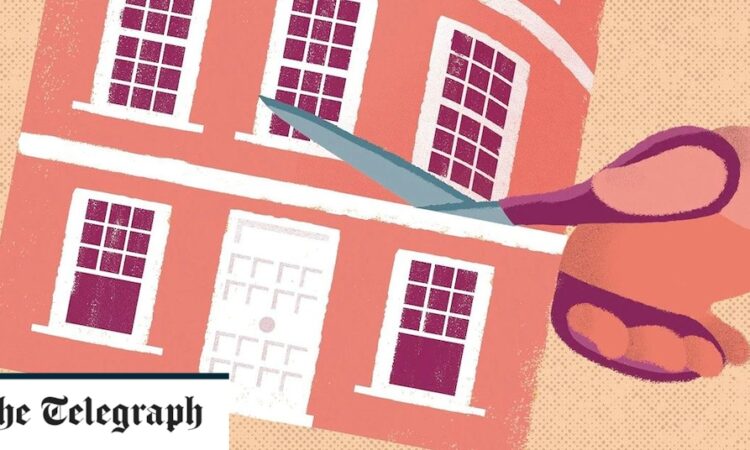
The damage higher interest rates is inflicting on commercial property prices has in fact been much greater. According to the MSCI monthly property index, commercial property prices are off 17pc since their June peak; even after December’s 1.5pc fall (as measured by the Halifax Index), house prices are still only 4pc lower than the peak, and remain 2pc up on the year.
If this is a “slump”, as sometimes depicted in the media, what would you call the equivalent figure for industrial, retail, warehouse and office space? A catastrophe? Well, compared to previous property meltdowns, it’s hardly that either. During the global financial crisis, commercial property prices are reckoned to have halved.
As it happens, the MSCI index is not a particularly instructive measure, substantially based as it is on professional valuations rather than real transactions. The relative weightings given to particular types of property are also open to question.
I’ve been looking for examples of high profile properties going for way below asking prices, and they are actually quite hard to find. If there is distress selling, it’s largely below the radar in sub-standard properties.
All the same, there is good reason to be wary. We tend to think of the global financial crisis as originating in a house price crash, and up to a point, it’s true. Some of the biggest losses were on so-called “collateralized debt obligations”, which were a method of securitising US housing loans.
Yet Britain’s very own banking meltdown had very little to do with the UK housing market as such, even if the first domino to fall was Northern Rock, a bog-standard mortgage lender.
Thanks to falling interest rates, both mortgage defaults and outright repossessions were low after the GFC compared to previous downturns. Never mind Northern Rock’s notorious 105pc mortgages, it was an unsafe funding model that floored the company, not an overheated housing market; NR’s mortgage book actually ended up delivering a substantial profit to taxpayers in runoff.
No, in the UK, the much bigger losses were on commercial property and other forms of highly leveraged lending. It was this type of exposure, not domestic mortgages, that wrecked HBOS and Royal Bank of Scotland Group. Those near-death experiences have made the banking sector doubly cautious ever since, such that exposure to commercial property is today little more than 6pc of all bank lending, against double that at the time of the GFC.
Similarly with the big, quoted property companies, where the rescue rights issues we saw back then would this time around seem unnecessary, even with a 20pc-plus correction to prices. On average, loan-to-value ratios are just 30pc, with much of the required finance fixed into the medium term future.
On the other hand, there has plainly been no shortage of speculative low cost finance pouring into commercial property since the last low point in 2009, so you kind of wonder where it has all been coming from. I guess we are about to find out.
The vulnerabilities, it would seem, are largely confined to the shadow banking sector. One way or another, the pain will be felt.
The fundamentals are these. The cost of finance has gone from 2pc to 6pc in less than a year; at the same time, a slowing economy is putting the brakes on demand, and therefore the requirement for new office, retail and industrial space.
To these age-old cyclical factors must be added a number of previously unseen structural influences. One is the increasingly chronic condition of physical retail, which Britain’s absurd local authority funding model, substantially based as it is on business rates and parking fines, conspires to make even worse.
Even the online world is not safe from today’s squeeze. Having bid up the cost of warehouse space to delusional levels, everyone is now violently reining in against a backdrop of wider shrinkage in demand for labour and space from big tech.
And finally we have the curse of work-from-home, which for many employees has become a permanent way of life, reducing demand for office space in some cases by 30pc or more.
Insiders say there is a distinction to be made between desirable footage which is energy efficient and well adapted to modern ways of working, and old fashioned, second tier property that is essentially obsolete. Maybe so. For the savvy investor, there will always be money to be made in UK property. But for the sector as a whole, that old truism looks ever more questionable.
As long as rents hold up, the pretence of current valuations can just about be sustained, but what happens when contracts expire, and tenants demand a cut?
As I’ve repeatedly stressed, this is not like previous downturns. It’s neither classically a balance sheet recession, like 2007-2008, or the more usual jobless contraction we associate with a previously overheating economy. So don’t expect its effect on property markets to follow precedent.
Rather, it is likely to prove a long, gradual, and drawn-out adjustment. Things may be looking better by the end of the year, but as soon as they do, the Government will again want to raise taxes to pay for the ruinous largesse of the past three years. The green shoots of recovery will struggle to establish themselves.
For the UK property market, there may not be a crash as such, yet the supercharged returns associated with the easy money of recent decades are a thing of the past.






